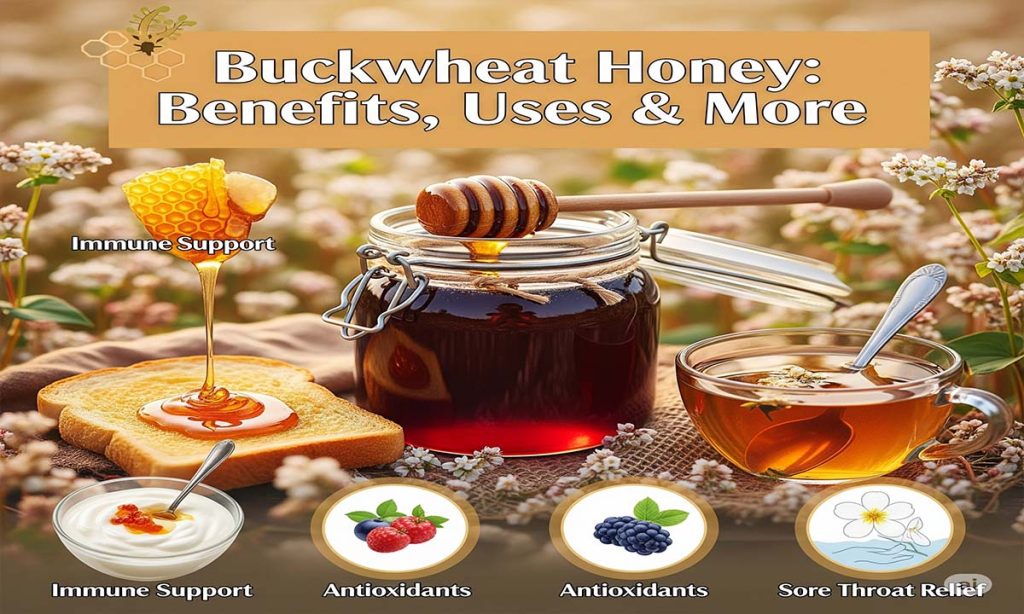Buckwheat honey is a unique, dark-colored honey with a rich flavor and potent health properties. It’s made by bees collecting nectar from buckwheat flowers, combining the nutritional strengths of buckwheat (a pseudo-grain) and pure honey. Unlike lighter honeys, buckwheat honey is less sweet but far richer in antioxidants. Traditional use and modern research both highlight its benefits: it may boost immunity, soothe coughs, aid wound healing, and improve digestion. In this article we explore what buckwheat is, its nutritional and antioxidant properties, the health benefits of raw honey, its distinctive taste and uses, and how it compares with Manuka honey.

Buckwheat honey stands out with its deep amber to nearly black color. This hue reflects an unusually high concentration of minerals and phenolic compounds. Buckwheat (the plant) is not actually a grain but a flowering plant related to rhubarb. Its tiny white blossoms yield nectar that bees turn into a robust, earthy honey. The flavor of buckwheat is distinct – often described as malty or molasses-like – more intense than common clover or wildflower honey. This makes it a gourmet ingredient for baking or cooking, as well as a flavorful “spoonful” sweetener in tea or yogurt.
Table of Contents
What Is Buckwheat Honey?
Buckwheat is produced from the nectar of buckwheat flowers. In the U.S., it’s traditionally made in states like New York, Montana, and the Dakotas. Because buckwheat blooms are small and nectar-sparse, bees must work hard, resulting in a honey that is notably dark and thick. Dutch Gold, for example, describes its Buckwheat Honey as “very dark in color” and “typically compared with blackstrap molasses,” with a “musty, earthy aroma”. In practice, pure buckwheat honey can range from dark amber to almost black. When you pour it, it’s viscous and richly colored – often with a reddish tint reflecting buckwheat’s pigments.
Nutritionally, buckwheat is more than just sugar and water. It is unusually rich in proteins, vitamins, minerals, and antioxidants. A scientific analysis found that buckwheat honey contained higher levels of sugars, proteins and total phenols (antioxidants) than Manuka honey. In fact, it had greater iron, manganese and zinc contents than Manuka as well. These minerals are vital for body functions. Likewise, clinical studies rank buckwheat honey very high in antioxidant activity. The dark color comes from polyphenols and flavonoids, which are powerful antioxidants. (Some sources report a low glycemic index for dark buckwheat – on the order of 48 – meaning it raises blood sugar more slowly than table sugar.) Raw buckwhea (unfiltered and unheated) is especially prized because it retains pollen, enzymes, and nutrients that may contribute to its health-promoting properties.
Nutritional & Antioxidant Properties
- High Antioxidants: Buckwheat is a powerhouse of antioxidants. It contains abundant phenolic acids (like p-hydroxybenzoic, chlorogenic and p-coumaric acids) and flavonoids. These compounds give it its dark hue and contribute to its antioxidant capacity. Scientific studies note that buckwheat honey often scores at the top of antioxidant rankings for honeys. This means it can help neutralize free radicals in the body, protecting cells from oxidative stress.
- Mineral-Rich: Compared to lighter honeys, buckwheat has more minerals. Tests show it has higher iron, manganese, and zinc than even Manuka honey. These trace minerals support immune function, wound healing, and overall metabolism.
- Natural Sugars & Enzymes: Like all pure honey, its primary sugars are fructose and glucose, but buckwheat honey’s overall sugar content is slightly higher. It also contains natural enzymes (e.g. glucose oxidase) and amino acids. When raw, those enzymes remain active, producing small amounts of hydrogen peroxide—another reason honey can fight microbes in wounds.
- Low GI (Potential): Some nutrition sources note that dark buckwheat has a relatively low glycemic index (~48). A GI of 48 is far below table sugar (GI ~65+) and means it won’t spike blood sugar as dramatically. This property may partly explain why one study found buckwheat helped lower blood glucose in diabetics. However, all honey still contains carbs, so it should be used judiciously by those watching blood sugar.
- Unique Phytochemicals: In addition to antioxidants, buckwheat may contain other bioactive compounds unique to buckwheat nectar. For example, research has identified certain phenolic compounds that contribute to its strong antibacterial and health-promoting effects.
Key Health Benefits of Buckwheat Honey
Buckwheat honey isn’t just sweet – it offers several notable health benefits backed by research:
- Immune Support: Rich antioxidants and phytochemicals in buckwheat honey can help bolster the immune system. A high level of polyphenols fights free radicals and reduces oxidative stress. People often use it during cold and flu season: taking a teaspoon of buckwheat daily can help give immune defenses a natural boost.
- Anti-Inflammatory: Chronic inflammation underlies many diseases. Buckwheat honey’s bioactive compounds have demonstrated anti-inflammatory effects. For example, it has been shown to reduce inflammation in lab studies, which may help ease conditions like arthritis or inflammatory skin issues when used internally or topically.
- Cough and Throat Soothing: Buckwheat honey is especially renowned for alleviating coughs and sore throats. Clinical trials have shown that a spoonful of buckwheat at bedtime can calm persistent coughing better than common over-the-counter medicines. In children with upper respiratory infections, buckwheat honey provided more relief and better sleep than codeine cough syrup. The mechanism is likely the honey coating the throat, plus its mild antimicrobial effect. (For reference, the Penn State College of Medicine study mentioned found buckwheat honey more effective and with fewer side effects than a codeine syrup.) Note: Honey should never be given to infants under 1 year old.
- Wound Healing & Skin Care: Honey’s use on cuts and burns is time-honored. Buckwheat honey excels here due to its high antioxidants and moderate antibacterial action. The high sugar content draws moisture from wounds and creates an environment hostile to bacteria. Clinical studies (including comparisons to Manuka) show that buckwheat can help wounds heal faster and cleaner. It’s also used in skincare: when applied to the skin, it can soothe irritation, hydrate, and help clear acne thanks to its antimicrobial and anti-inflammatory properties.
- Digestive Health: Buckwheat honey may act as a mild prebiotic. Its rich antioxidant content can promote gut health by supporting beneficial bacteria. Some users report relief from indigestion or ulcers when they regularly consume a little buckwheat. The prebiotic effect of honey helps maintain a healthy microbiome.
- Blood Sugar Regulation: Several sources note that buckwheat honey can help keep blood sugar levels more stable than refined sugar. One study found people with type 2 diabetes who ate buckwheat had better post-meal glucose levels than those who ate ordinary sugar. This may be due to its antioxidants, slightly lower GI, and the honey’s fructose-to-glucose balance. However, moderation is key, and diabetic individuals should treat it as they would any sugar.
- Heart Health: Buckwheat honey may support cardiovascular health. In research, it was found to help reduce total cholesterol and LDL (“bad” cholesterol) in people who consumed it regularly. Lower cholesterol and blood pressure can result from the antioxidants and nitric oxide-related effects. Overall, these factors contribute to a lower risk of heart disease.
- Brain & Mood: While not extensively studied specifically for buckwheat, honey’s nutrients (B vitamins, amino acids, etc.) have been linked to better cognition and mood. The calming ritual of honey in tea can also reduce stress and support restful sleep, especially when used instead of refined sugar.
Each of these benefits has been observed in research or clinical trials. For example, healthline notes: “Buckwheat honey was found to help reduce cholesterol levels… [and] one study found that buckwheat honey was more effective than over-the-counter cough medicine”. HoneyCritique similarly calls buckwheat honey “a powerhouse of antioxidants” that aids the immune system, digestion, and wound healing.
Uses of Buckwheat Honey
- Culinary Uses: Buckwheat honey’s bold, molasses-like flavor makes it ideal in recipes that benefit from a dark, robust sweetener. Use it in baking (whole wheat breads, gingerbread, molasses cookies), in marinades or barbecue sauces (it complements smoky meats and bold cheeses), or whisked into vinaigrettes for a sweet balance. Try it on toast with butter or in oatmeal, or swirl into yogurt and smoothies. Because it’s less intensely sweet, you may need a bit more than you would white sugar. It also dissolves well in tea and coffee – many tea drinkers prefer buckwheat honey in herbal teas for its rich flavor and throat-soothing properties.
- Medicinal Uses: Buckwheat honey is commonly used as a home remedy. As noted, a spoonful can relieve a cough or sore throat. For colds, try honey with lemon or warm herbal tea. Applied topically, pure buckwheat honey can soothe sunburn, cuts, and acne (spread a thin layer on clean skin and rinse off). It’s an ingredient in some natural lip balms and face masks to hydrate skin.
- General Sweetener: Beyond recipes, buckwheat is a lovely everyday sweetener for health-conscious kitchens. Use it on pancakes, waffles, or drizzled on Greek yogurt. It’s also a popular addition to cheese boards – its malty notes pair beautifully with sharp cheddar, blue cheese, or goat cheese (as Dutch Gold suggests).
- Beverages: Baristas sometimes use buckwheat in specialty drinks. It can sweeten and flavor coffee (e.g. in a buckwheat honey latte) or tea. It’s also a traditional sweetener in certain meads (honey wines) made with buckwheat honey, lending them a deep color and flavor.
- Routine Health Booster: Some people simply take a teaspoon of buckwheat each day as a supplement. You can do this straight or dissolve it in warm water with ginger as a daily elixir.
When using buckwheat honey in cooking, remember it has a distinct taste – if you’re substituting for sugar in a recipe, taste as you go, and perhaps mix it with a milder honey if a subtler flavor is desired.
Buckwheat Honey vs. Manuka Honey: Key Differences
Buckwheat honey and Manuka honey are both prized for health, but they have different profiles:
- Color & Flavor: Buckwheat honey is very dark (brown to nearly black) with a strong, malty-molasses flavor. Manuka honey ranges from medium brown to dark brown with a distinctive earthy, herb-like taste. If you love bold, robust flavors, buckwheat is ideal; if you prefer a rich but earthy note, Manuka fits.
- Antioxidant Content: Buckwheat generally has higher antioxidant levels. The deep polyphenols give it intense antioxidant power. In fact, one study showed buckwheat honey’s cellular antioxidant activity is higher than that of Manuka honey. This makes buckwheat excellent for overall health, aging, and inflammation reduction.
- Antibacterial Power: Manuka honey is famed for its high methylglyoxal (MGO) content, giving it very potent antibacterial action, even against drug-resistant bacteria. Buckwheat also has strong antibacterial effects. Research found its activity against pathogens (like Staphylococcus aureus) is comparable to Manuka’s. In fact, some studies suggest buckwheat honey can be as potent or more against certain bacteria than Manuka. However, Manuka’s antibacterial reputation (with UMF/MGO ratings) means it’s often chosen for wound care.
- Unique Benefits: Both honeys support immune health and wound healing. Buckwheat tends to be highlighted for its antioxidants and anti-inflammatory effects, whereas Manuka is valued for its antimicrobial strength (urinary tract infections, acne, oral health).
- Price & Availability: Manuka honey is usually much more expensive than buckwheat honey. Buckwheat provides a more affordable way to get healthful honey benefits. Both can be found online and in health stores, but manuka often commands a premium.
In summary, neither is definitively “better” – it depends on your needs. If antioxidant support and value are your goal, buckwheat is excellent. If you need a powerful antibacterial honey (e.g. for wound dressings), Manuka might be preferred. The choice can even depend on taste preference (buckwheat’s strong molasses vs Manuka’s earthy sweetness). Both are “super honeys” with loyal followings.
Taste, Texture & Culinary Pairings
Buckwheat honey’s taste and aroma are distinctive: rich, earthy, and slightly spicy or malty. Descriptors often include musky, smoky, molasses-like, or coffee-like. It may also have hints of chocolate or licorice to some palates. Because of this complexity, it pairs well with strong flavors. For example:
- Savory pairings: Try buckwheat drizzled on aged blue cheese or goat cheese (the sweetness balances the cheese’s tang). It’s also excellent in glazes for roasted meats (pineapple-honey glazed ham is a classic, but buckwheat deepens the flavor).
- Baking: It enriches whole-grain breads and pumpkin or ginger breads. Use it in place of molasses or brown sugar for a rich color and taste. It works in barbecue sauce (as Dutch Gold suggests, “add some zest to your BBQ sauce”).
- Tea & Drinks: Buckwheat gives herbal teas (chamomile, ginger-lemon) a complex sweetness. Honey in coffee is less common, but in lattes or special brews it can replace sugar nicely.
Texturally, buckwheat honey is thick. Over time in the jar it may crystallize (becoming semi-solid); gently warming the jar (not microwaving!) will re-liquefy it without losing nutrients. Always use a clean spoon to avoid contamination.
Where to Buy Buckwheat Honey
If you’re asking “where can I buy buckwheat honey?” or searching “buckwheat honey near me”, you have several options:
- Local Farms and Farmers’ Markets: The best buckwheat honey is often local. Check farmers’ markets or farm stores in areas where buckwheat is grown (e.g. parts of the U.S. Northeast, Midwest, or in countries like Poland/Ukraine). Many local beekeepers harvest and sell raw buckwheat. Buying local ensures freshness and supports small producers.
- Specialty Health Food Stores: Natural foods stores (Whole Foods, Sprouts, etc.) frequently carry raw and single-flower honeys. Look for “buckwheat honey” on the label. It may be with other honeys or in the natural sweeteners section.
- Online Retailers: If local sources are scarce, try online. Major retailers like Amazon, Thrive Market, or dedicated honey shops have buckwheat honey. Popular brands include Dutch Gold’s Buckwheat Honey and Gunter’s Pure Honey Buckwheat. (For example, Dutch Gold markets a “Buckwheat 1 lb” jar described as “a robust, dark honey… ideal for baking or soothing a cough”.) Searching online for “buckwheat honey raw” or “buy buckwheat honey” will turn up options. When shopping online, check reviews and sourcing information to ensure purity.
- International Options: Buckwheat honey is also produced in Eastern Europe (Poland, Romania, Ukraine) and Asia (Japan). If available, imported buckwheat honeys can be excellent.
When buying, look for raw, unfiltered buckwheat honey on the label. This means minimal processing (so all beneficial enzymes and pollen remain). Also ensure it’s pure buckwheat (some honeys are blends). The jar should list simply “pure buckwheat” as the ingredient.
Tip: Use online map searches or Google with your location and keywords like “buckwheat honey near me” to find local sellers or shops. Many small apiaries have Facebook pages or websites. Some beekeepers offer mail-order.
Precautions and Storage
- Not for Infants: Do not give buckwheat or any honey to children under 1 year old. Infant botulism risk applies to all honey.
- Allergies: Rarely, people with pollen allergies may react to honey. If sensitive, start with a small taste. Buckwheat pollen count is often high, so allergies could be more likely.
- Storage: Keep honey in a cool, dry place. Buckwheat will crystallize over time (a sign of purity). You can gently warm the jar in a bowl of hot water to re-liquefy it; do not microwave.
- Quantity: Even though honey has health properties, remember it’s mostly sugar. Use it in moderation within a balanced diet.
Frequently Asked Questions
Q: What is buckwheat honey?
A: Buckwheat honey is a type of monofloral honey made by bees that collect nectar from buckwheat flowers. It is much darker and richer in antioxidants than typical light honeys. Its flavor is strong and malty, unlike sweet clover or wildflower honeys. Nutritionally, it contains higher levels of phenolic compounds, minerals (like iron and zinc), and proteins than many other honeys.
Q: What are the benefits of buckwheat honey?
A: Buckwheat honey offers several health benefits. It’s rich in antioxidants, which help protect cells and reduce inflammation. It can boost immunity and digestion (it even acts as a mild prebiotic). Notably, studies show it can calm coughs and sore throats better than some medicines. It also helps in wound healing and may lower cholesterol. Overall, its antioxidant and antimicrobial properties make it a “functional food” that supports general health.
Q: How does buckwheat honey compare to Manuka honey?
A: Both are “special” honeys with health perks, but they differ. Buckwheat honey has higher antioxidants and a strong molasses-like taste. Manuka honey (from New Zealand) is famous for its exceptionally strong antibacterial methylglyoxal (MGO) content. In fact, buckwheat’s antibacterial power has been found to be as high or even higher than Manuka’s against some bacteria. The trade-off is that Manuka is usually more expensive. If you want an antioxidant boost and a bold flavor on a budget, buckwheat is great. If you need potent antibacterial action (for skin infections, ulcers, etc.), Manuka might be preferred. The “better” choice depends on your needs.
Q: Can buckwheat honey help with coughs or colds?
A: Yes. Research shows that buckwheat honey can be an effective cough suppressant. In a pediatric study, children who took buckwheat honey at night coughed less and slept better than those given codeine-based cough syrup. Many people find a spoonful of buckwheat on its own or in herbal tea soothes sore throats and coughs. Its thick texture coats the throat, and its antimicrobial properties may help fight infection. Keep in mind: honey should not be given to infants under 1 year old.
Q: Where can I find/buy buckwheat honey?
A: Buckwheat honey is often available through health food stores, farmers’ markets, and online retailers. Look for local apiaries or regional co-ops where buckwheat is grown. Searching online for “buckwheat honey near me” can reveal nearby shops or beekeepers. Popular brands include Dutch Gold Buckwheat and Gunter’s Buckwheat Honey, among others. Always choose raw, unfiltered buckwheat honey for the best quality.
Q: What does buckwheat honey taste like?
A: It has a bold, earthy, almost spicy sweetness. Many describe it as malty or molasses-like, sometimes with hints of coffee or chocolate. It’s far stronger than regular honey, so it may be an acquired taste. Mixing it into foods or drinks can make the flavor more approachable.
Q: Is raw buckwheat honey better than processed?
A: “Raw” means the honey hasn’t been heat-treated or heavily filtered. Raw buckwheat honey retains more enzymes, pollen, and nutrients. These components contribute to its health benefits. So raw buckwheat honey is generally considered better for health purposes than pasteurized (processed) honey. Look for labels that say “raw” or “unpasteurized.”
Q: How should I store buckwheat honey?
A: Store it in a cool, dark cabinet at room temperature. Avoid refrigeration. Over time, buckwheat may crystallize (it becomes grainy); this is natural. If needed, gently rewarm the jar in warm water to re-liquefy it.
Encourage Engagement
If you found this guide helpful, please share it on social media or with friends who love natural remedies! We’d love to hear about your experience with buckwheat honey — drop a comment below with your favorite uses or recipes. Your feedback helps others learn about this unique honey.
Sources: Information compiled from health experts and research studies, including a medically reviewed article on buckwheat honey and recent comparisons with Manuka honey. These sources detail buckwheat composition, antioxidant activity, and health effects.





3 thoughts on “Buckwheat Honey: Benefits, Uses, and More”